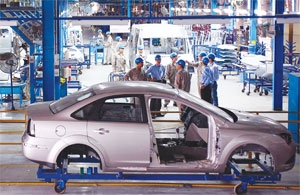Auto sector hits the brakes
 Most auto industry players face losing their market shares unless they are shifted into specialised importers after enforcement of the ASEAN-China free trade agreement (ACFTA) with low import tariffs.
Most auto industry players face losing their market shares unless they are shifted into specialised importers after enforcement of the ASEAN-China free trade agreement (ACFTA) with low import tariffs.
The ACFTA, effective from January 1, 2010, was considered a gateway opening the door for Chinese-made automobiles and spare parts to flow into South East Asia. Under agreement terms, from 2010 China and six ASEAN members Thailand, Malaysia, Indonesia, the Philippines, Singapore and Brunei will impose 0.1-0.6 per cent tariffs on imported automobiles and parts from relevant countries. Remaining countries Vietnam, Myanmar, Laos and Cambodia will apply these tax levels from 2015.
This means not until 2018 when the import of completely built units (CBUs) into Vietnam will benefit from zero per cent import duty under AFTA’s common effective preferential tariffs (CEFT) scheme local auto industry will face tough competition from imported units.
In fact, Chinese automobiles have not won plaudits from local consumers in the past years. It was evidenced through low sales figures associated with Chinese auto brands like Haima, Geely and Lifan in the Vietnamese market.
By contrast, import value of auto parts and components into Vietnam climbed to $72 million in the first five months of 2012. Imports of replacement parts and components from China is forecast to shoot up in the coming period, especially when import duties will go down under ACFTA terms.
Besides, with a complete production infrastructure, strong supporting industries development and clear investment incentives some ASEAN countries continue to be manufacturing bases for global auto manufacturers.
In respect to Vietnam’s auto industry future perspective, industry players assumed at most three stronger brands could survive tough business conditions, while most remaining local auto firms would have to shift into acting as professional importers to retain their market share upon implementation of Vietnam’s commitments with the international community.
Vietnam currently reports a density of 18 automobiles per 1,000 residents. The Ministry of Industry and Trade forecasts the demand for under 10-seat personal cars in Vietnam will escalate after 2020 on the back of noticeable improvements in per capita people’s incomes and transport infrastructure.
Accordingly, by 2015 from 166,000-235,000 new cars will be added, increasing to 246,000-347,000 cars by 2020 and 592,000-836,000 cars by 2025. Of them, trucks and buses will account for 27 per cent, the remainder will be personal cars.
This means by 2015 Vietnam will need to inject $12 billion into auto imports each year, thus worsening trade deficit picture if the country fails to develop under 10 seat car lines.
What the stars mean:
★ Poor ★ ★ Promising ★★★ Good ★★★★ Very good ★★★★★ Exceptional
Related Contents
Latest News
More News
- Government moves to establish International Financial Centre (December 21, 2025 | 21:00)
- Vietnam's IFC to target global investment flows (December 21, 2025 | 18:00)
- Two national hospitals expand capacity with new facilities (December 20, 2025 | 09:00)
- Ha Tinh breaks ground on major Vingroup industrial and energy projects (December 19, 2025 | 18:24)
- EVN launches major power infrastructure projects nationwide (December 19, 2025 | 18:17)
- VAL inaugurates second production line to meet domestic animal feed demand (December 19, 2025 | 16:37)
- Sun Group pioneers urban tram system in Phu Quoc (December 19, 2025 | 15:00)
- Seven major projects launched to drive Hanoi’s next growth phase (December 19, 2025 | 14:00)
- Securing capital and efficiency for Vietnam’s 2026-2030 growth ambitions (December 17, 2025 | 10:00)
- Vietnam bucking trend in the global M&A landscape (December 16, 2025 | 14:20)

 Tag:
Tag:




















 Mobile Version
Mobile Version